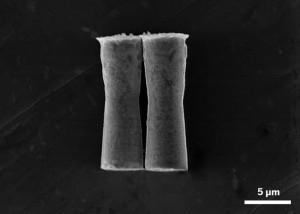
The jet-propelled motors can swim though gastric acid by reducing hydrogen ions into hydrogen gas.
Image: ACS Nano
In a new study, researchers have developed a micromotor that can propel itself though the body to the stomach lining to deliver cargo.
While engineers have been developing micromotors for some time, it wasn’t until now that anyone has tested the device inside an animal. Researchers state that the results of this experiment show the potential of motorized particles to possibly improve the functions of nanoparticle drug carriers and imaging agents.
The micromotors were tested on mice to see the motor’s ability when delivering cargo to the stomach walls. Because the particles are jet-propelled, the researchers believed that they would be able to penetrate the layer of thick mucus that lines the stomach.
This from Chemical & Engineering News:
The team first compared the micromotors with ones that were filled with platinum, which doesn’t react with acid to form propellant bubbles, instead of zinc. The researchers used a tube to deliver precise doses of the two particle types into the stomachs of mice. After two hours, nearly four times as many zinc micromotors as platinum particles remained in the stomach tissue, suggesting that the jet-propelled motors could penetrate that thick mucus layer.
The results of the experiment showed that loading cargo in micromotors can improve the efficiency of delivery, which means these tiny machines may soon be swimming through bodies to deliver drugs, take tissue samples, or even perform small surgical repairs.
Further, the micromotors completely dissolved after the deliver and left no toxic by-products.
Want to see more research on micromotors? Head over to the Digital Library to see what our scientist are doing in the field.


